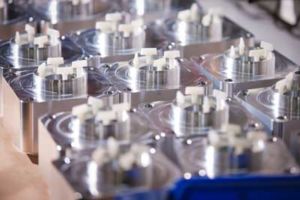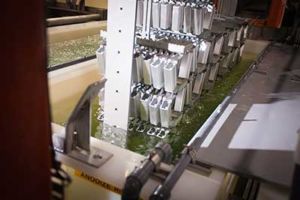Product Design & Development (July 2014)
To better control the increasing product development costs without sacrificing quality, medical device OEMs are turning to aluminum instead of other more costly materials to manufacture both their new and existing components.
The following 10 tips will help manufacturers improve their designs for aluminum medical components earlier in the product development process, lower their overall manufacturing costs, and speed product time to market.
1. Determine design intent.
When developing new components, designers need to fully understand the end usage and share this information with their aluminum component manufacturer. The more a manufacturer understands about the product’s end use, the more constructive design guidance they can offer as there are different ways to meet design challenges more effectively, efficiently, and economically, when using aluminum rather than alternative materials. For instance, rolled shapes riveted together can be replaced by a single aluminum extruded profile, resulting in higher strength, while eliminating joining costs.
2. Determine critical-to-function (CTF) areas.
For increased strength, lighter weight, or ease of assembly with mating components, designers need to think through their component’s dimensions and features to reap all the benefits of aluminum. Aluminum extrusions, for example, offer optimum strength-to-weight ratios where wall thickness or profile adjustments can be made to lower the component’s weight and still ensure its overall strength.
3. Determine critical/non-critical tolerances.
Aluminum extrusion profiles can be made to precise tolerances or to standard dimensional tolerances. Designers need to determine the tolerances that are truly important for each specific part feature or mating part(s). By collaborating with component manufacturers to achieve design intent, applying only the truly CTF tolerances to the print will result in less manufacturing time.
4. Understand mating components with regard to part features and final assembly.
The versatility of aluminum extrusion makes it an ideal process for incorporating features that make it easier to assemble components with their mating pairs. A snap-fit hinge allows for ease of assembly and does not require special tools. Other features, such as dove-tail slots, screw bosses, or internal screw chases, can significantly minimize assembly time with mating components. Thinking through the final assembly needs and resources in the design phase can help designers

Extruded components designed with screw bosses, hinges, and many other features, allow them to incorporate easily with mating components. The metal alloy’s properties combined with surface finishing give designers the wear resistance and reliability they need in a medical device component.
determine features up front that can assist not only with expediting final assembly, but also contribute to developing ergonomic and safe assembly practices – a critical process in medical device manufacturing.
5. Understand cosmetic needs/requirements.
Designers need to determine the finished look for their aluminum components to decide the best manufacturing method to suit their goals. They should design with surface finish in mind. When extruding aluminum, any surface features or transition areas can create cosmetic flow lines on the exposed surfaces. Designs can incorporate surface features, such as raised drill lines, grooves, or scallops to hide flow lines. It’s also important to consider packaging up front. Selecting packaging that separates parts and avoids freight damage during shipping helps assure products arrive in expected condition.
6. Design for manufacturability.
It is crucial to determine the best manufacturing process to get you closest to near-net shape, or the final shape. Work with a supplier who is trained to specifically examine your product manufacturing needs and recommend an innovative manufacturing solution.
7. Select the best aluminum alloy for the manufacturing process and product usage.
Design engineers must understand their component’s critical design absolutes, functional needs, estimated annual usage, and product manufacturing processes when choosing their preferred aluminum alloy. Different alloys offer different properties and some are better for certain processes than others. Some alloys extrude at a faster rate, some are easier to bend, and some accommodate machining processes better than others. Alloy choice can have a significant effect on surface finish, as well.

Aluminum extrusion offers easy-to-care-for surface finishes and non-corrosive material properties, making it ideal for repeated use and cleaning in a sterile medical environment.
8. Determine best finish.
Components that don’t require a finished look can be left in their raw form. Designers need to keep in mind that sometimes after the process of applying a chemical finish, such as anodizing and hard coat, the after-finish tolerances will be affected because the process adds a layer of thickness to the component. It’s important to understand how different finishes may affect final form, fit and function. Finishing options for your components can be driven by the need to enhance heat dissipation, corrosion or wear resistance.
9. Understand the properties of aluminum.
An ideal material of choice for many product applications, aluminum is not only lightweight – about a third of the weight of steel – but its natural finish offers a protective oxide coating that resists corrosion. Aluminum’s electrical and thermal conductivity is also almost as good as copper, and it is 100 percent recyclable, and requires just five percent of the energy originally required to produce the primary metal.
10. Design to meet regulatory/compliance requirements.
A must-have for any medical device product is compliance with regulatory requirements. RoHS and REACH regulations, for instance, challenge manufacturers to understand the substances contained in their products. Whether the regulations restrict certain hazardous substances (RoHS) in electrical and electronic equipment, or require registration, evaluation and authorizations of chemicals (REACH), OEMs should work with suppliers who have in-depth knowledge and the ability to help them meet regulatory requirements.
Getting what you expect in the shortest time possible at a competitive cost is a success metric we all share. Medical device OEMs who use aluminum instead of other materials and start project work with their suppliers as early in the design phase as possible can reduce their overall costs while elevating product quality.
